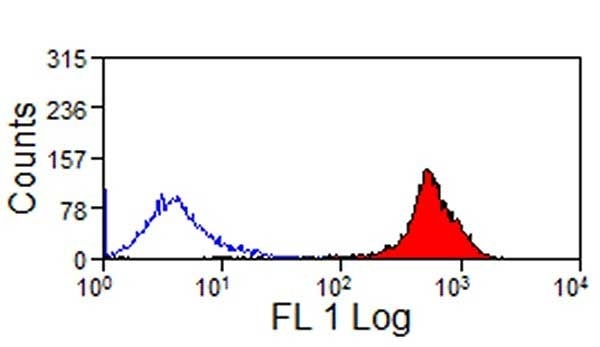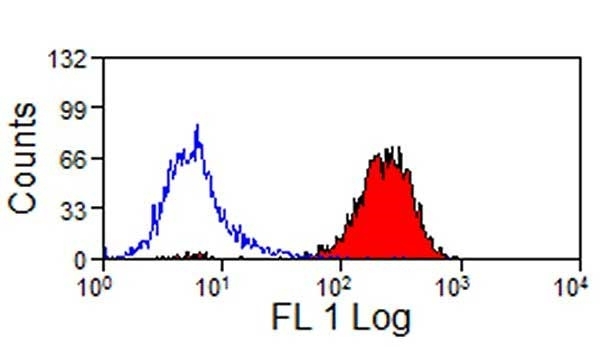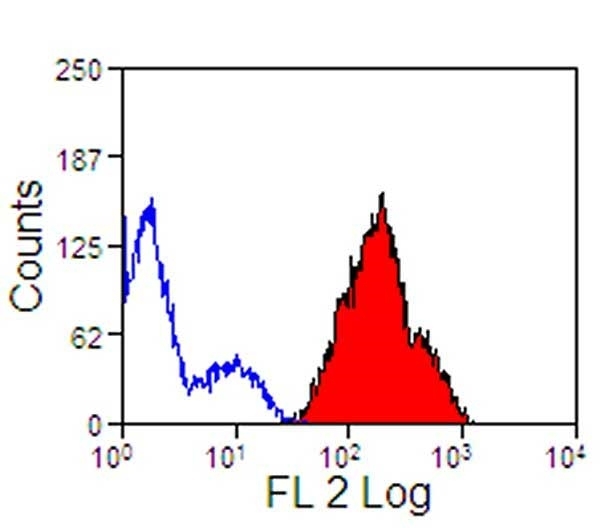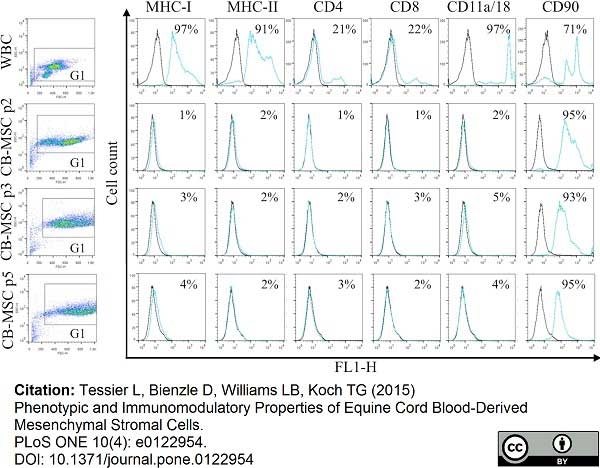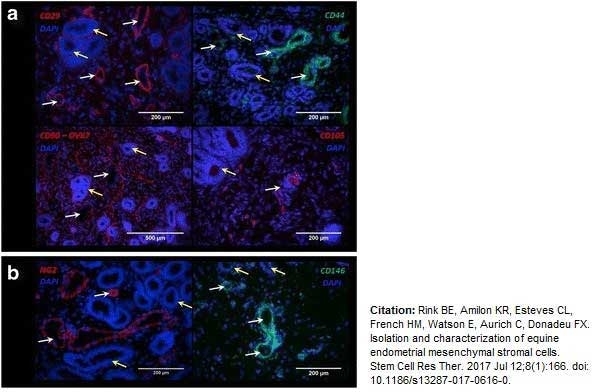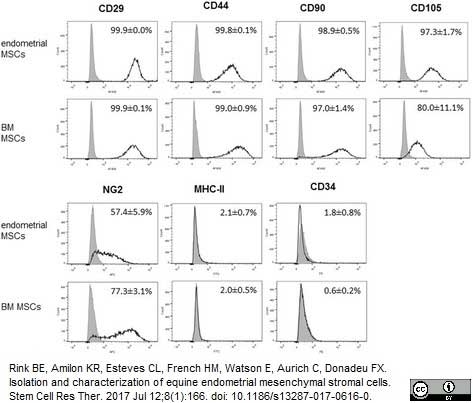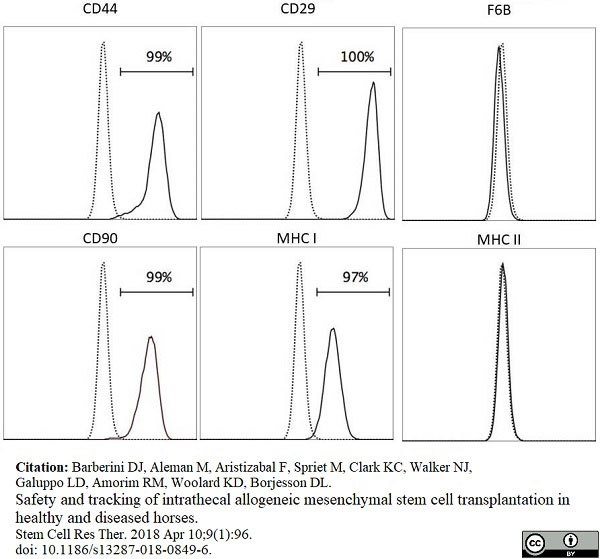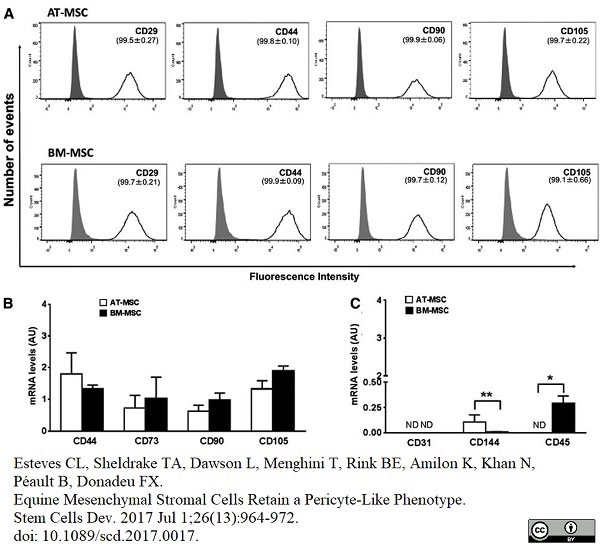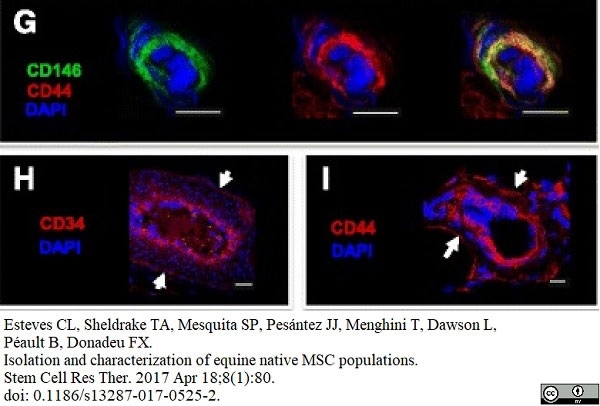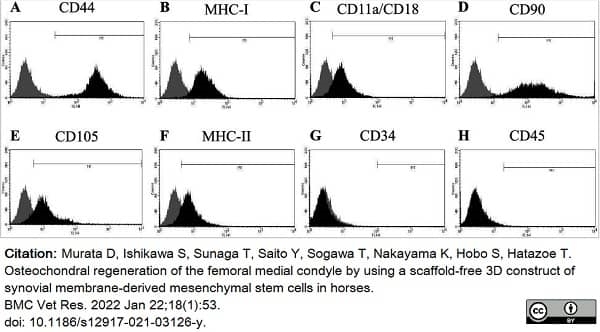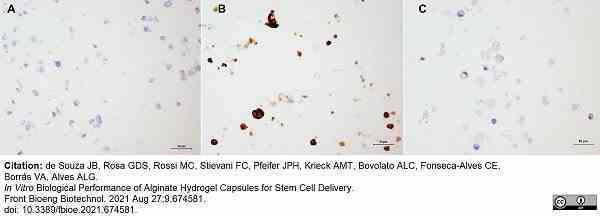CD44 antibody | CVS18











Mouse anti Horse CD44
- Product Type
- Monoclonal Antibody
- Clone
- CVS18
- Isotype
- IgG1
- Specificity
- CD44
| Mouse anti Horse CD44 antibody, clone CVS18 recognizes equine CD44, a plasma membrane glycoprotein broadly expressed on the cell surface of leucocytes. CD44 is the primary receptor for hyaluronate and functions in cell adhesion. Mouse anti Horse CD44 antibody, clone CVS18 may be used as a pan equine leucocyte marker. |
- Target Species
- Horse
- Product Form
- Purified IgG - liquid
- Preparation
- Purified IgG prepared by affinity chromatography on Protein G from tissue culture supernatant
- Buffer Solution
- Phosphate buffered saline
- Preservative Stabilisers
- 0.09% sodium azide (NaN3)
- Carrier Free
- Yes
- Immunogen
- Equine leucocytes.
- Approx. Protein Concentrations
- IgG concentration 1.0 mg/ml
- Fusion Partners
- Spleen cells from immunised mice were fused with cells of the X63-Ag 8.653 mouse myeloma cell line.
- Regulatory
- For research purposes only
- Guarantee
- 12 months from date of despatch
Avoid repeated freezing and thawing as this may denature the antibody. Storage in frost-free freezers is not recommended.
| Application Name | Verified | Min Dilution | Max Dilution |
|---|---|---|---|
| Flow Cytometry | 1/25 | 1/200 | |
| Immunohistology - Frozen |
- Flow Cytometry
- Use 10μl of the suggested working dilution to label 106 cells in 100μl
References for CD44 antibody
-
Kydd, J. et al. (1994) Report of the First International Workshop on Equine Leucocyte Antigens, Cambridge, UK, July 1991.
Vet Immunol Immunopathol. 42 (1): 3-60. -
Rappocciolo,G. et al. (2003) Down-regulation of MHC class I expression by equine herpesvirus-1
J Gen Virol. 84: 293-300 -
De Schauwer, C. et al. (2012) In search for cross-reactivity to immunophenotype equine mesenchymal stromal cells by multicolor flow cytometry.
Cytometry A. 81: 312-23. -
Radcliffe, C.H. et al. (2010) Temporal analysis of equine bone marrow aspirate during establishment of putative mesenchymal progenitor cell populations.
Stem Cells Dev. 19: 269-82. -
Carrade, D.D. et al. (2012) Comparative Analysis of the Immunomodulatory Properties of Equine Adult-Derived Mesenchymal Stem Cells().
Cell Med. 4 (1): 1-11. -
Maia, L. et al. (2015) Feasibility and safety of intrathecal transplantation of autologous bone marrow mesenchymal stem cells in horses.
BMC Vet Res. 11 (1): 361. -
Maia L et al. (2013) Immunophenotypic, immunocytochemistry, ultrastructural, and cytogenetic characterization of mesenchymal stem cells from equine bone marrow.
Microsc Res Tech. 76 (6): 618-24. -
Soboll, G. et al. (2003) Mucosal co-administration of cholera toxin and influenza virus hemagglutinin-DNA in ponies generates a local IgA response.
Vaccine. 21 (21-22): 3081-92.
View The Latest Product References
-
Tessier, L. et al. (2015) Phenotypic and immunomodulatory properties of equine cord blood-derived mesenchymal stromal cells.
PLoS One. 10 (4): e0122954. -
Spaas, J.H. et al. (2015) Chondrogenic Priming at Reduced Cell Density Enhances Cartilage Adhesion of Equine Allogeneic MSCs - a Loading Sensitive Phenomenon in an Organ Culture Study with 180 Explants.
Cell Physiol Biochem. 37 (2): 651-665. -
Gomiero, C. et al. (2016) Tenogenic induction of equine mesenchymal stem cells by means of growth factors and low-level laser technology.
Vet Res Commun. 40 (1): 39-48. -
Clark, K.C. et al. (2016) Canine and Equine Mesenchymal Stem Cells Grown in Serum Free Media Have Altered Immunophenotype.
Stem Cell Rev. 12 (2): 245-56. -
Alvarenga, A.M. et al. (2016) Feasibility and Safety of Endometrial Injection of Autologous Bone Marrow Mesenchymal Stem Cells in Mares
J Eq Vet Sci. 42: 12-18. -
Lepage, S.I. et al. (2016) Generation, Characterization, and Multilineage Potency of Mesenchymal-Like Progenitors Derived from Equine Induced Pluripotent Stem Cells.
Stem Cells Dev. 25 (1): 80-9. -
Maia, L. et al. (2017) Conditioned medium: a new alternative for cryopreservation of equine umbilical cord mesenchymal stem cells.
Cell Biol Int. 41 (3): 239-248. -
Maumus, M. et al. (2016) Utility of a Mouse Model of Osteoarthritis to Demonstrate Cartilage Protection by IFNγ-Primed Equine Mesenchymal Stem Cells.
Front Immunol. 7: 392. -
Maia, L. et al. (2017) A proteomic study of mesenchymal stem cells from equine umbilical cord.
Theriogenology. 100: 8-15. -
Rink, B.E. et al. (2017) Isolation and characterization of equine endometrial mesenchymal stromal cells.
Stem Cell Res Ther. 8 (1): 166. -
Maia, L. et al. (2015) Feasibility and safety of intrathecal transplantation of autologous bone marrow mesenchymal stem cells in horses.
BMC Vet Res. 11: 63. -
Dos Santos V, H. et al. (2019) Evaluation of alginate hydrogel encapsulated mesenchymal stem cell migration in horses.
Res Vet Sci. 124: 38-45. -
Barberini, D.J. et al. (2018) Safety and tracking of intrathecal allogeneic mesenchymal stem cell transplantation in healthy and diseased horses.
Stem Cell Res Ther. 9 (1): 96. -
Esteves, C.L. et al. (2017) Equine Mesenchymal Stromal Cells Retain a Pericyte-Like Phenotype.
Stem Cells Dev. 26 (13): 964-72. -
Esteves, C.L. et al. (2017) Isolation and characterization of equine native MSC populations.
Stem Cell Res Ther. 8 (1): 80. -
Tongu, E.A.O. et al. (2021) Allogenic mesenchymal stem cell-conditioned medium does not affect sperm parameters and mitigates early endometrial inflammatory responses in mares.
Theriogenology. 169: 1-8. -
Murata, D. et al. (2022) Osteochondral regeneration of the femoral medial condyle by using a scaffold-free 3D construct of synovial membrane-derived mesenchymal stem cells in horses.
BMC Vet Res. 18 (1): 53. -
Bernardino, P.N. et al. (2022) Therapeutics prior to mesenchymal stromal cell therapy improves outcome in equine orthopedic injuries.
Am J Vet Res. 83 (10): ajvr.22.04.0072. -
Papa, P.M. et al. (2023) Intratesticular transplantation of allogenic mesenchymal stem cells mitigates testicular destruction after induced heat stress in Miniature-horse stallions.
J Equine Vet Sci. 132: 104961. -
Carvalho, A de M. et al. (2013) Isolation and characterization of equine peripheral blood-derived multipotent mesenchymal stromal cells
Pesquisa Veterinária Brasileira. 33 (9): 1151-4. -
Fülber, J. et al. (2021) Chondrogenic potential of mesenchymal stem cells from horses using a magnetic 3D cell culture system.
World J Stem Cells. 13 (6): 645-58. -
Cabezas, J. et al. (2020) In vitro preconditioning of equine adipose mesenchymal stem cells with prostaglandin E(2), substance P and their combination changes the cellular protein secretomics and improves their immunomodulatory competence without compromising stemness.
Vet Immunol Immunopathol. 228: 110100. -
de Souza, J.B. et al. (2021) In Vitro Biological Performance of Alginate Hydrogel Capsules for Stem Cell Delivery.
Front Bioeng Biotechnol. 9: 674581. -
Cassano, J.M. et al. (2023) Preliminary evaluation of safety and migration of immune activated mesenchymal stromal cells administered by subconjunctival injection for equine recurrent uveitis.
Front Vet Sci. 10: 1293199.
Further Reading
-
Burk, J. et al. (2013) Equine cellular therapy--from stall to bench to bedside?
Cytometry A. 83 (1): 103-13.
- Synonyms
- H-CAM
- PGP-1
- UniProt
- Q05078
- Entrez Gene
- CD44
- GO Terms
- GO:0007155 cell adhesion
- GO:0016021 integral to membrane
- GO:0004872 receptor activity
- GO:0005540 hyaluronic acid binding
MCA1082GA
If you cannot find the batch/lot you are looking for please contact our technical support team for assistance.
Please Note: All Products are "FOR RESEARCH PURPOSES ONLY"
View all Anti-Horse ProductsAlways be the first to know.
When we launch new products and resources to help you achieve more in the lab.
Yes, sign me up